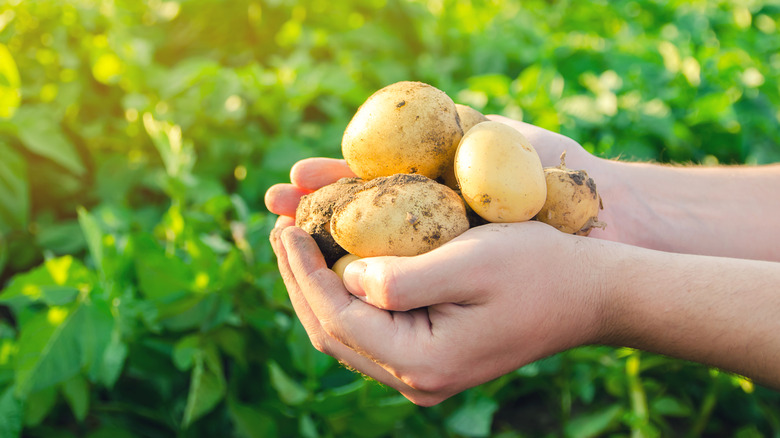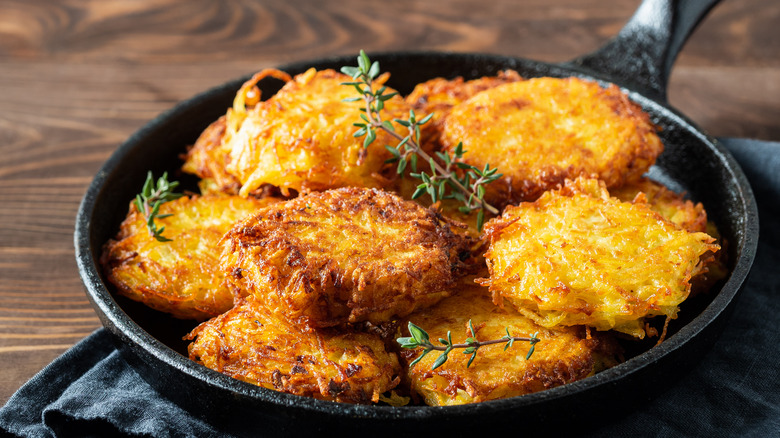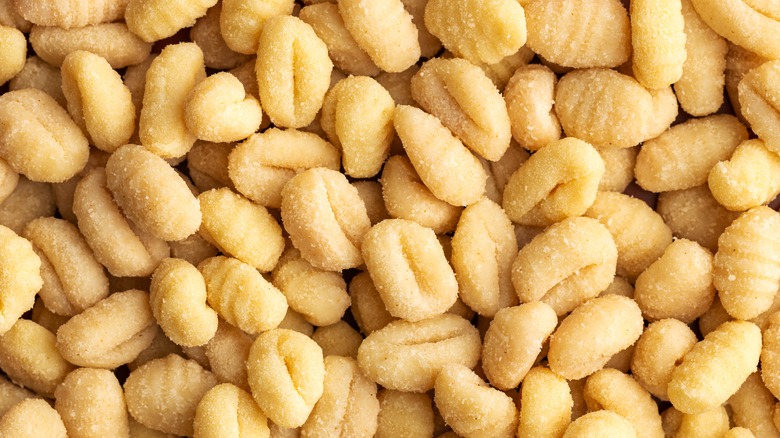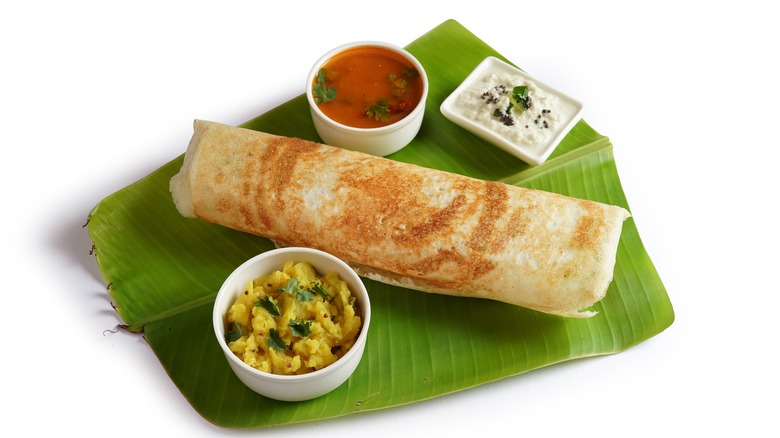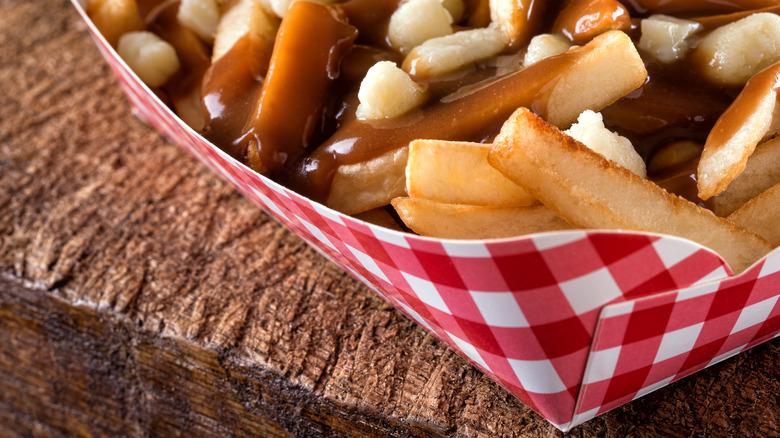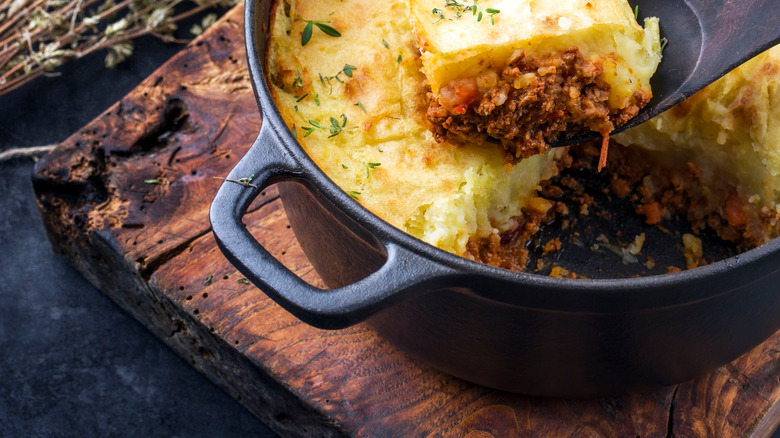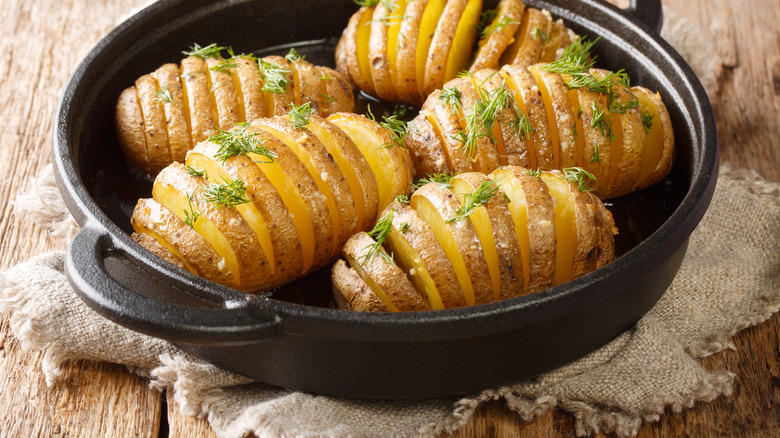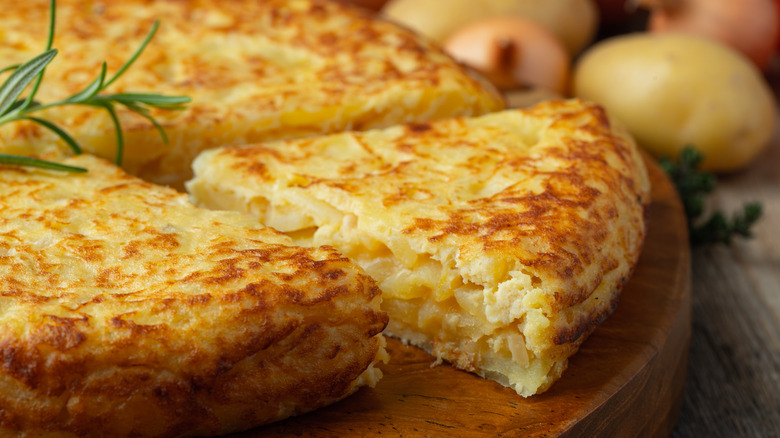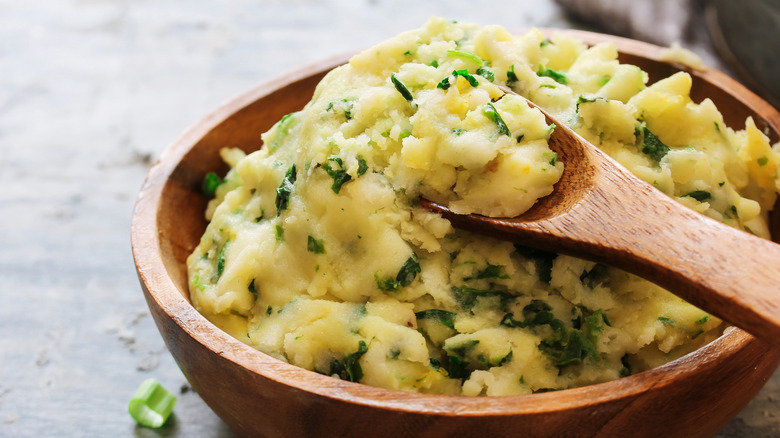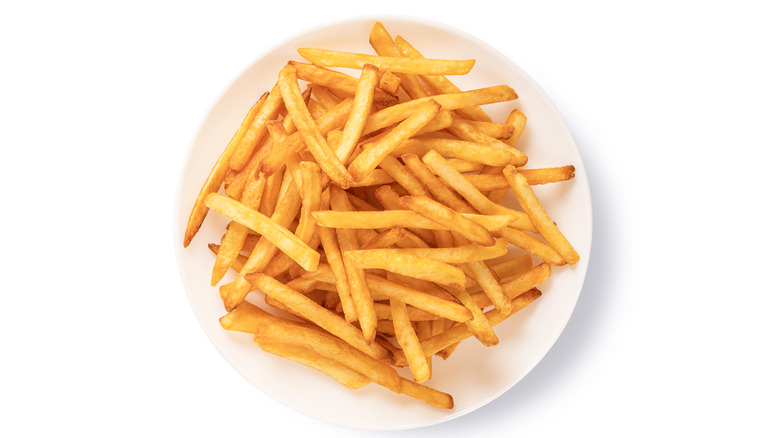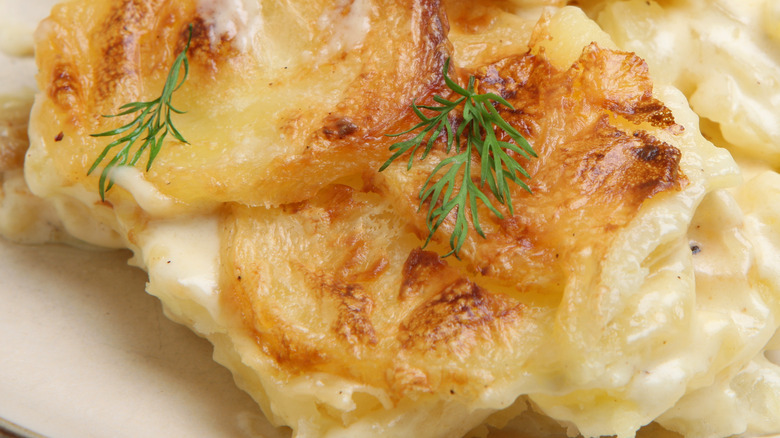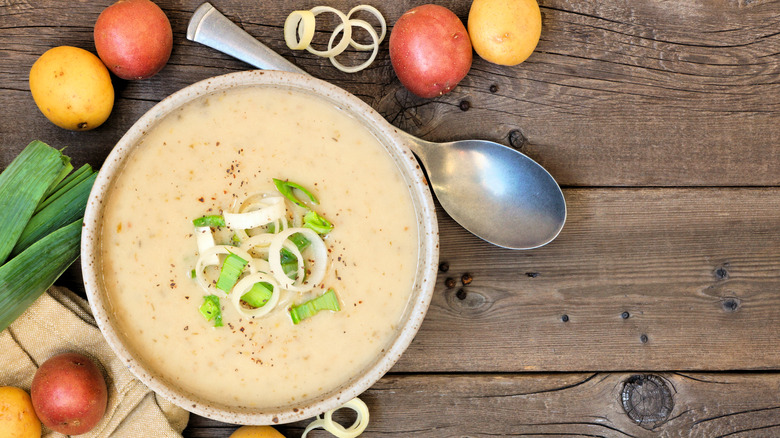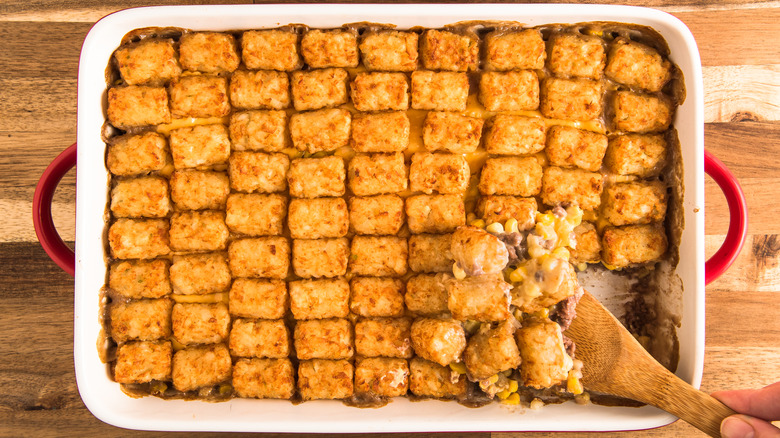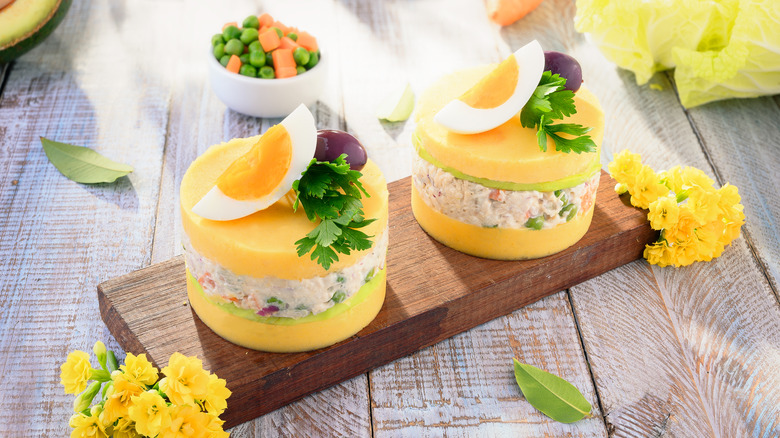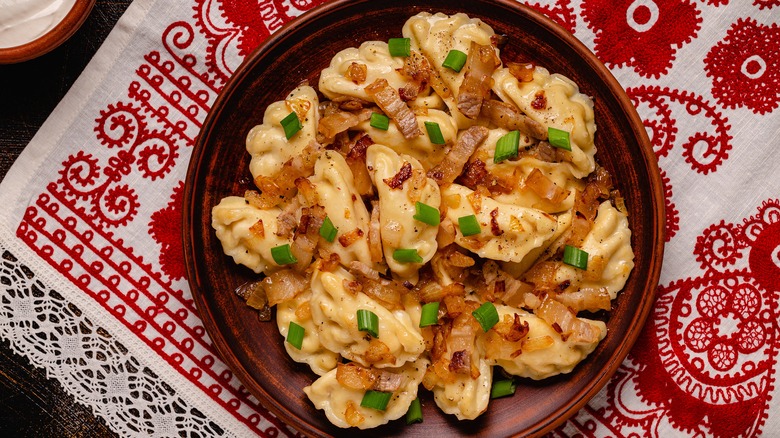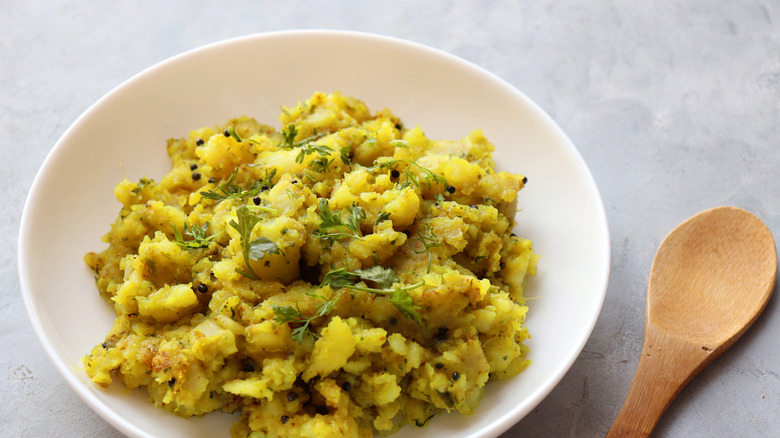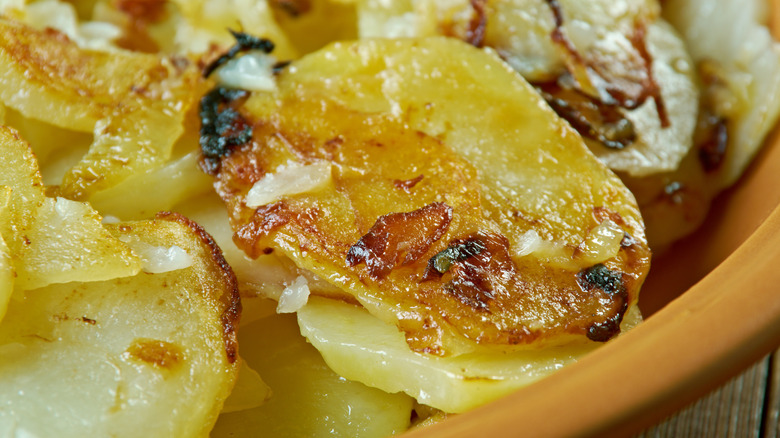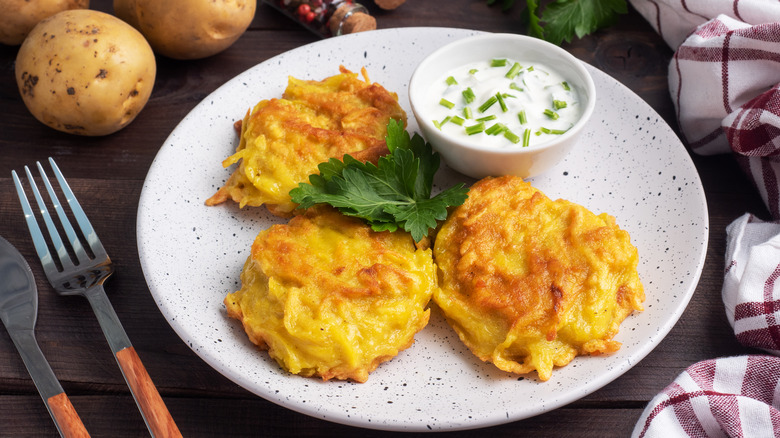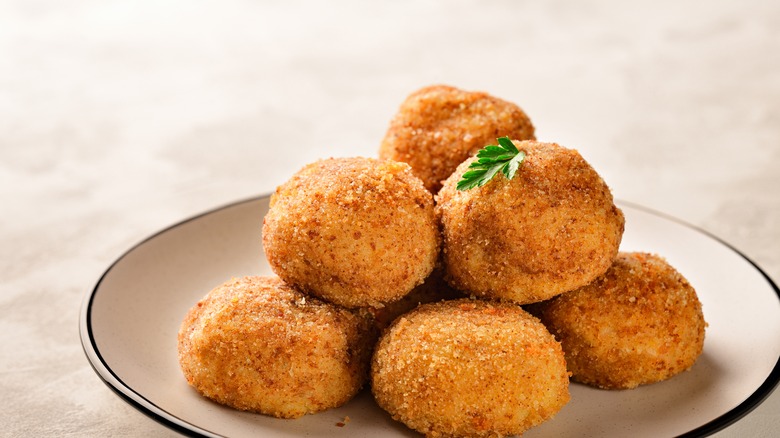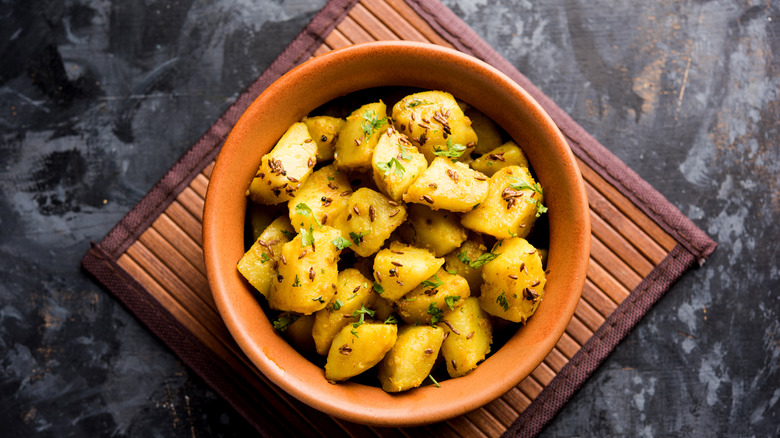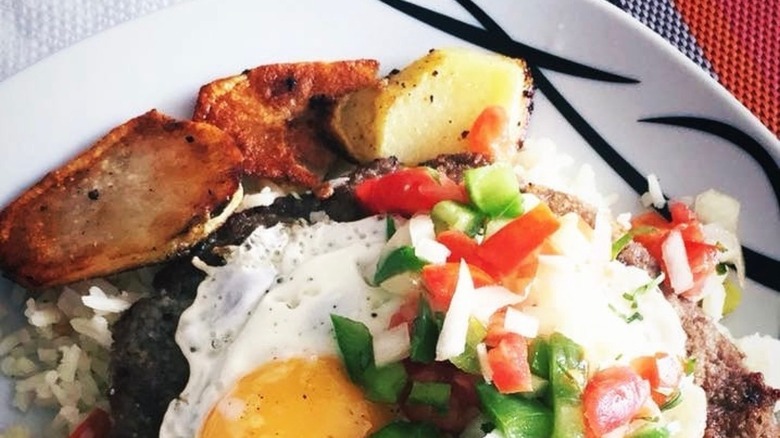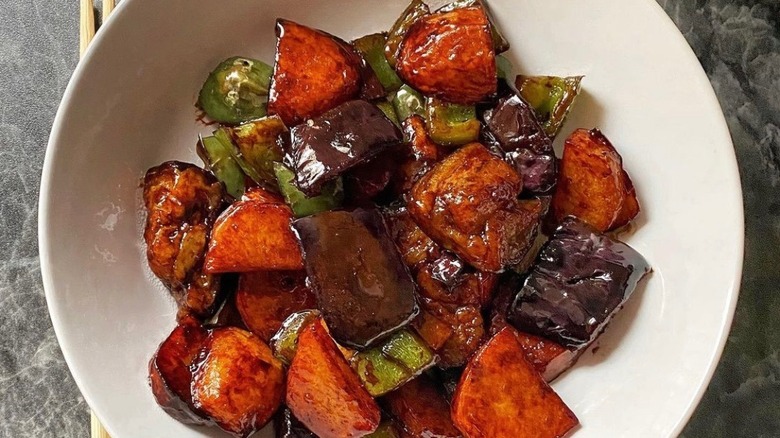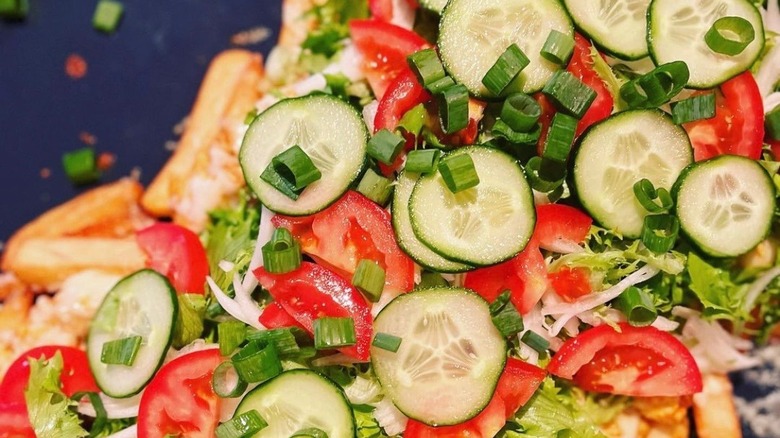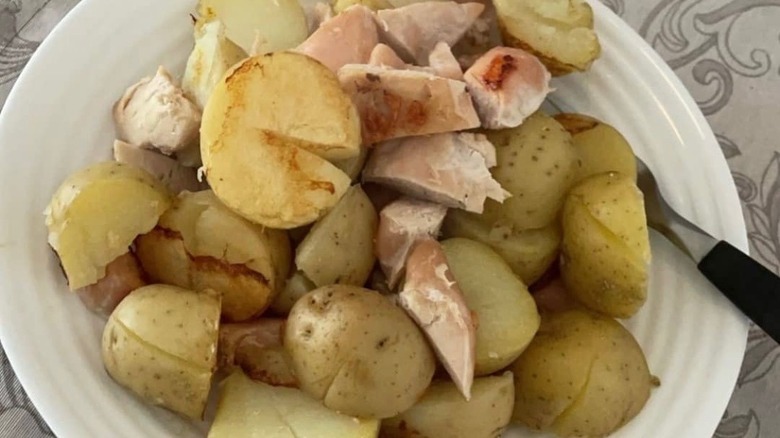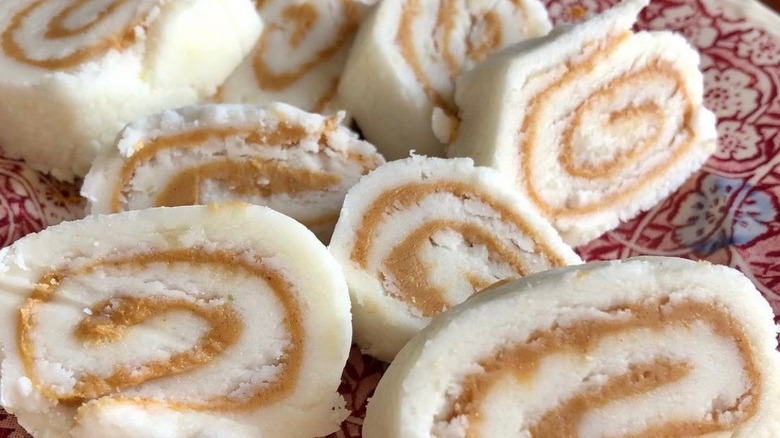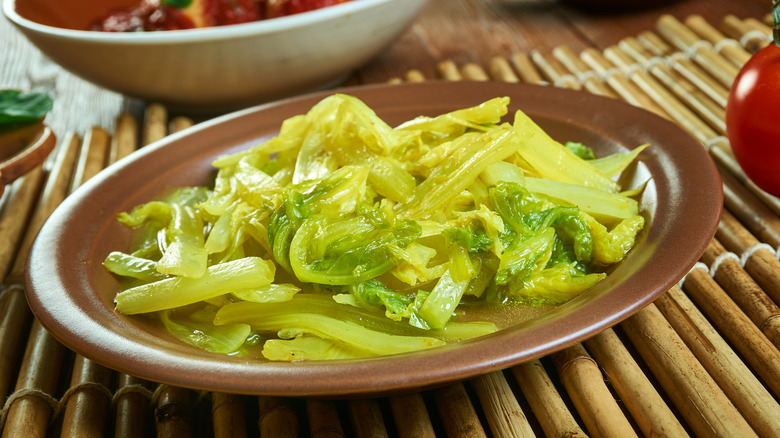25 Ways Potatoes Are Eaten Around The World
It's hard not to fall in love with the potato. There are dozens of ways to prepare this tuber, and cultures around the world have adopted the potato as a dietary staple. After all, potatoes are relatively low cost, have nutritional benefits, and offer a blank canvas for regional ingredients and flavors.
The potato was endemic to the Andes region of South America 8,000 years ago but moved to North America and Europe with the movement of colonizers in the 1500s (via BBC Travel). The potato comes in numerous sizes, shapes, colors, and varieties, but all have a similar starchy texture and mild flavor. Potatoes are an excellent source of electrolytes like potassium, as well as vitamins and minerals (via UC Davis).
Here are some ways people have adopted potatoes into regional cuisines and flavors worldwide. From colcannon to potato candy, you'll never look back to ordinary mashed potatoes again.
Latkes (Jewish)
Latkes are savory potato pancakes made from shredded potatoes, grated onion, and seasoning. "Latke" translates to "pancake" in Yiddish, per Merriam-Webster. These pancakes were initially served for the Jewish holiday of Hanukah but have since been adopted by others worldwide.
The similarities between the latke and the hash brown open up the possibility of serving latkes as a side for your savory breakfast or brunch meal. You can substitute the potatoes in the recipe for sweet potatoes, grated zucchini, or grated carrots instead. After frying and draining to remove the excess oil, you can also top latkes with freshly chopped scallions, applesauce, or sour cream.
Gnocchi (Italy)
Gnocchi are small potato dumplings made from rolling mashed potatoes, other savory ingredients, and flour into tiny, bite-sized pieces. According to Saveur, it's believed that gnocchi originated in Italy between the 1500s and 1600s, and this simple food has since been adapted to suit different regional sauce preferences.
In Veneto, Italy, gnocchi are eaten with a thin red sauce, while gnocchi in Lombardy is served in a butter sauce with a ton of Parmesan cheese (via The Pasta Project). Although standard russet or baking potatoes are commonly used for gnocchi, you can also make a variation on the traditional dish and enjoy sweet potato gnocchi.
Masala dosa (India)
Dosas are tasty Indian street crepes — the only way to make dosas better is to fill them with potatoes. Masala dosas are made from a thin lentil and rice pancake folded around a spiced potato batter. The potatoes are tossed with cumin, brown mustard, ginger, and the like before adding them to the crepe.
Traditionally, dosas are folded into cylindrical shapes, but some recipes have adapted the fold to include ornate triangles and cones. The masala dosa is often served with coconut chutney, chili oil, and an okra-tamarind stew called sambar. When you bite into one of these delicious savory pancakes, you'll get a variety of textures, flavors, and spices.
Poutine (Canada)
Poutine is a Canadian delicacy of french fries piled high with gravy and cheese curds. The dish originated in Quebec in the 1950s (via the New York Times). Still, it spread from "poutineries" (eateries that specialize in this particular dish) to bars, restaurants, and fast food places across the nation and into the United States (via The Canadian Encyclopedia). You can also see poutine in fine dining applications from restauranteurs like Martin Picard's foie gras poutine. Although two different restaurants are in contention for who actually created the famous dish, Canadians have widely accepted it as a uniquely Canadian culinary masterpiece (via Chatelaine). After all, it's hard not to love fries, gravy, and cheese curds.
Shepherd's pie (Ireland and Great Britain)
For folks unfamiliar with shepherd's pie, this dish contains layers of corn, peas, and ground beef topped with mashed potatoes and baked until slightly firm. According to The Greatist, the shepherd's pie may have emerged during the 1500s in Ireland following the introduction of the potato — a cheap piece of produce — to the region's poor Catholic population.
The first Irish pies likely used mutton. The wealthier British were avid beef eaters, so the shepherd's pie eventually evolved to include this more expensive type of ground meat. Shepherd's pie has gone on to include many additional ingredients and substitutions, including a Thanksgiving turkey and stuffing shepherd's pie.
Hasselback potatoes (Sweden)
Hasselback potatoes fit the definition of a perfectly engineered food product: a maximum surface area for the ultimate crispiness and topping potential. According to Hasselbacken, this potato preparation, which slices potatoes into an accordion shape on a wooden skewer, was first created in Sweden during the 1950s.
Hasselback potatoes can be baked or fried, and some variations of the recipe use sweet potatoes instead of regular baking potatoes. The shape of the potato makes it easy to slide pieces of cheese between each of the folds or sprinkle a bit of bacon on top for a savory surprise.
Spanish omelet (Spain)
The Spanish omelet, or tortilla Española, is a frittata-like egg dish served for tapas (or small plates). The potatoes for this dish are first fried in a shallow pan of oil before drying on a paper towel. The potatoes are then added back into the pan and topped with a layer of eggs to cook until the eggs are firm. The disc is flipped to cook on its other side, just like an omelet.
Spanish omelets can be served with a variety of sauces and seasonings, but tortilla wedges usually accompany them. This frittata-like breakfast dish combines all of your brunch favorites into one — minus the mimosa.
Colcannon (Ireland)
Colcannon was one of the first forms of mashed potatoes globally (via the Smithsonian Magazine). This Irish mashed potato dish combines cooked cabbage and onions with mashed potatoes with butter and milk. Some recipe variations also add a bit of heavy cream in lieu of the milk for a creamier mashed potato with a more decadent flavor. Others may use kale in place of cabbage.
Colcannon can be served with gravy or eaten as-is for a hearty boost of folate and fiber from the kale, per the Mayo Clinic. And if you aren't fond of kale (and to that, we don't blame you), you can use green cabbage instead.
French fries (Belgium)
Although french fries have since spread globally, thanks largely to the Golden Arches, Belgium lays claim to this form of fried potatoes (via BBC). "Frenching" is not related to the country of France, but rather a preparation method that slices the potatoes into tiny sticks that expose all sides of the tuber.
The country of France may be a little salty about this claim, but the French (along with almost every other country across the globe) still love their french fries, whether the fries are shoestring, steak cut, or covered in ketchup. You can also make sweet potato fries instead, but we would argue nothing replaces the classic spud.
Potatoes dauphinoise (France)
French potatoes dauphinoise differ from other potatoes-and-cream recipes, such as a gratin or scalloped potatoes, because this dish omits cheese. These potatoes are rich and creamy and usually served with steak or roasted pork. According to French Moments, this potato dish was named after the French region it was developed in — Dauphiné.
To make it, russet potatoes are sliced and layered with heavy whipping cream (don't skimp on the fat here), garlic, thyme, and pepper for a soft casserole that will impress any dinner guest. The potatoes are just soft enough, but not mushy, because of the long bake time in the oven.
Leek and potato soup (Wales)
Potato leek soup is an uber-rich, flavorful winter soup guaranteed to warm your belly and soul. The recipe combines a hearty potato (like a russet or a Yukon Gold) with the grassy flavoThe leeks are traditionallyeks are often grown in the highlands of Wales because of the area's high precipitation and deep rich soils (via Travel About Britain).
To prepare potato leek soup, the ingredients are cooked down until soft before puréeing with an immersion blender. Other countries besides Wales have variations on potato leek soup, including France and Scotland, but the Welsh are widely recognized to have ownership over this soup (via the Daily Maverick).
Hot dish (United States)
Hot dish is a Midwestern potato casserole that can use a variety of frozen potatoes (popularly frozen hash browns or Tater Tots) along with canned soup, sour cream, and cheese. Several variations on the hot dish recipe include everything from meats like bacon, chicken, or sausage to other dairy products, such as cream cheese. Minnesota hotdish, for example, combines the essential crunchy element of tater tots with corn and peas, ground beef, and cream of mushroom or cream of chicken soup.
Whether as one word (hotdish) or two, hot dish is a popular food because it uses virtually any canned ingredient in your pantry and lets you walk away from the meal while it's baking. In short, the hot dish is Midwestern hospitality and economy at its finest.
Causa (Peru)
Causa is a Peruvian egg dish that layers mashed potatoes with mayonnaise and ají amarillo, a Peruvian yellow pepper. Recipe variations include the traditional chunked tuna, shredded chicken, or mushrooms.
The word "causa" (Spanish for "cause") may imply the dish's function in providing sustenance for Peruvian soldiers who went on to fight in battles across the region (via Eat Peru). During the War of the Pacific, causa was a popular dish prepared for soldiers, "para la causa," meaning "for the cause (of winning the war)."
Causa's flavors are as unique as the shape. It is typically formed into a cylinder using a small springform pan and resembles something you may find in a French bistro.
Pierogis (Poland)
Pierogis are a Polish dumpling dating back to the 1500s that have since evolved into the delicious savory treat we know today (via Pierogi Heaven). You can also find pierogis in America since the 1700s with the movement of immigrants from Eastern Europe.
While pierogis are stuffed with everything from seafood to sweet berries, the most traditional preparation method is the pierogi Ruskie. This version is loaded with cottage cheese, mashed potato, and onion and served with sour cream and pork crackling on top. Pierogis are eaten as a meal, snack, or for holidays like Christmas and often served with mushrooms and sauerkraut.
Batata bhaji (India)
Batata bhaji is symbolic in India for more than just its flavors. These turmeric-colored potato cubes are found at banquets and dinner tables, usually as a side dish to dal and rice (via Ministry of Curry). Batata bhaji can also be served as a main course with other Indian classics like roti or chapati.
The potato dish is made with a blend of spices like turmeric, mustard seeds, cumin, asafoetida, curry leaves, and fresh ginger. According to Condé Nast Traveller, the potato emerged in India in the 1700s with the movement of Dutch and Portuguese traders into the country. Batata bhaji eventually became an important part of Hindu rituals and served as a naivedya — an offering to the gods.
Lyonnaise potatoes (France)
The French are at it again with Lyonnaise potatoes. Unlike cream-heavy French potato dishes such as gratin or potatoes dauphinoise, Lyonnaise potatoes are made by frying potatoes in a fat (usually butter, but a recipe may also use lard, oil, clarified butter, or duck fat) with onion. These potatoes are first parboiled and thinly sliced for ultimate crispiness.
The first Lyonnaise potatoes appeared in French history in 1845 and have lasted as a flavorful companion to meats and other French dishes (via the Taste the World Cookbook). The dish itself is named after the city of Lyon, in the French Rhone-Alpes region.
Boxty (Ireland)
Ireland stakes claim to numerous potato dishes, including boxty. These potato pancakes straddle the line between mashed potato and fritter because the recipe for these Irish potatoes contains both ingredients.
To make boxty, shredded potatoes are added to mashed potatoes, along with buttermilk, seasoning, flour, and a leavening agent. According to Taste Leitrim, adding buttermilk provided soluble fats and texture. It is believed that the word "boxty" is derived from the Irish word "arán bocht tí," meaning "poor-house bread," or the word "bacstaí," meaning "to bake."
The fried potato dish is often served for breakfast alongside smoked salmon, sour cream, sausages, fried egg, or bacon. The texture is perfectly crispy and gets you the best of both worlds — in terms of potatoes, at least.
Papas rellenas (Cuba)
Papa rellenas is a Cuban dish found on many islands in the Caribbean. Ground beef or picadillo (a mix of ground beef, paprika, cumin, oregano, tomato sauce, green olives, and cilantro) are combined around a scoop of mashed potatoes before the ball is breaded and deep-fried until golden brown.
Papa rellenas are served with a mixture of mayonnaise and ketchup or without any dipping sauce, depending on the setting in which the appetizer is consumed. This recipe can also be vegan by substituting ground beef for a mixture of peas and carrots, but most recipes stick to the beef filling.
Jeera aloo (Bangladesh)
Jeera aloo is a Bangladeshi potato dish filled with Northern Indian herbs and spices. In Hindu, "jeera" translates to "cumin" (via the Collins Dictionary), so you can expect that these potatoes are well-seasoned with that spice in both ground and whole forms.
Besides the cumin, this potato dish is full of heat from dried ginger, coriander, and red chili powder. Some recipes use fresh ginger for a zingy taste, but ground ginger can provide a pungent ginger undertone without obscuring the other flavors in the dish. Jeera aloo can be served as a side with basmati rice or as a filling in Kathi rolls.
Silpancho (Bolivia)
Silpancho isn't just a Bolivian potato — it's an entire meal. This dish starts with a bed of white rice covered in thinly-sliced fried potatoes, a pounded-flat burger patty, tomato salsa, and a hard-boiled egg on top (via 196 Flavors).
Celia la Fuente Peredo, a Bolivian chef from Cochabamba, received credit for creating this dish. According to Taste Atlas, the name of the dish is a derivative of the word Quechuan word "silpanch'u," which means "thin and pounded" (referring to the thinly pressed beef patty). This dish is full of flavors and delicious, filling ingredients that make one harmonious plate.
Di san xian (China)
Di san xian is a popular Northern Chinese stir-fry dish made with eggplant, potato, and bell pepper. According to Dr. Alan Hoenig's book "Eating Out in China," the name roughly translates to "three fresh delicacies" because the veggies are some of the most widely available produce at markets in the region. The trio of sliced vegetables are tossed over high heat in a sauce of dark and light soy sauces, granulated sugar, and cornstarch, then served on a platter over hot, steamed white rice. It's a simple recipe for novice cooks, delicious to eat, filling, and vegan.
Kapsalon (Netherlands)
Kapsalon is a street food dish found in Rotterdam. Unlike other potato dishes from around the world, this Dutch favorite is a hybridization of flavors, textures, and foods from several cuisines. You'll find a bed of fries, Middle Eastern shawarma, grated Gouda cheese, and salad greens, topped with garlic sauce and the Indonesian chile paste called sambal oelek.
This multicultural dish was the product of hairdresser Nathaniël Gomes mixing his favorite foods together in 2003 (via Dutch Review). In fact, the word "kapsalon" roughly translates to "hairdresser" to pay homage to Gomes' menagerie of flavors. Other variations of the recipe include the substitution of chicken, fish, or falafel for the shawarma.
Canarian wrinkly potatoes (Canary Islands)
Canarian wrinkly potatoes (also known as papas arrugadas) is a side dish served in the Canary Islands. It is important to note that the residents of the Canary Islands, which is located off the coast of Spain, call potatoes "papas" (the indigenous word), while the Spanish language typically uses the word "patatas," per Cook's Info.
The original potatoes in this recipe were cooked in seawater so that the skin of the potatoes wrinkles. Most island cooks serve papas arrugadas with a red mole sauce called mojo rojo, made with red bell peppers or chilis. The potatoes can be served as a side dish for main entrées like steak or pork.
Potato candy (United States)
Potatoes — as a candy? Believe it or not, some regions in Appalachia do indeed transform potatoes into candy. According to True Treats Candy, the potato has been converted into candy throughout history in Germany, France, Ireland, and Russia — but the addition of peanut butter is uniquely American.
The taste of potato candy isn't anything like a fried potato since cooking the potato down removes most of its flavor qualities. The two main ingredients — mashed potato and powdered sugar — are cooked down into a moldable ball rolled with peanut butter and sliced into small spiraled discs. It is believed that peanut butter was used because of its relative inexpensiveness.
Atkilt Wat (Ethopia)
Atkilt wat is a flavorful Ethiopian dish made by stewing potatoes, cabbage, carrots, onions, and peppers. Atkilt wat is especially important for Ethiopian Orthodox Christians abstaining from consuming meat a few days a week (via Best of Vegan). Some variations on the recipe substitute the cabbage for collard greens.
Atklit wat is usually served on a plate with other Ethiopian dishes like injera (teff flour bread), other types of stews, and vegetables. It lacks the same berbere heat as other Ethiopian foods, so it is the perfect veggie complement to different foods. The soft texture of the stewed vegetables can further complement other foods on the Ethiopian table.
